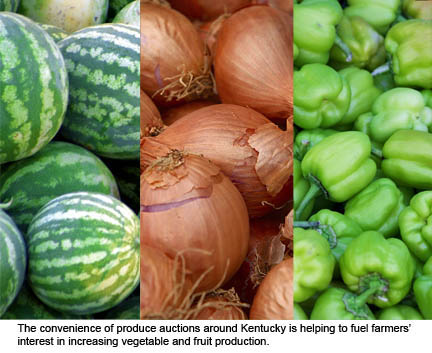Auctions Helping Fuel Increased Produce Production
Auctions Helping Fuel Increased Produce Production

In four locations across the state, produce auctions are booming and their success is benefiting their local economies.
Tim Woods, an extension professor in agricultural economics at the University of Kentucky, has been keeping an eye on the increase in produce production Kentucky has seen in recent years. That growth is reflected in the increased interest in local produce auctions.
“We’ve seen a pretty steady growth in participation in produce auctions here in recent years,” Woods said. “We’re seeing more and more farmers that are participating, using those as market channels on top of some of the other places that they’re selling. It’s a really good deal for selling produce.”
It wasn’t that long ago when marketing Kentucky fruits and vegetables was more trouble than it was worth for many growers who might have seen a healthy crop of cabbage or bell peppers sell for a price below the break-even point or, even worse, rot in the field without a buyer. But those days may be gone, with the onset of a variety of sales options, including the rise of produce auctions in the state.
Preliminary results from the 2007 Produce Planting and Marketing Intensions Survey, compiled by Woods, indicate an over all 8 percent acreage increase for produce crops, from last year, with 11,514 additional acres planned for 2007. Vegetable acreage in particular is projected to be up 11% over 2006. The growing availability of direct market channels may have had an impact on the increase. According to the survey, marketing through farmers markets, directly to restaurants, community supported agriculture programs, on-farm retailing and auctions have all shown increased numbers of farmers selling at least 10 percent of their produce through these channels.
The oldest auction in the state is the 10-year-old Fairview Produce Auction in Christian County. Lincoln County’s auction is four years old and Bath and Buffalo Trace both have young auction houses. The convenience of selling through auction has enticed some growers to test the market waters.
“For folks looking at entering the produce world, a lot of them are starting fairly small,” Woods said. “These kinds of produce auctions really are a nice marketing platform to sell at a fairly small scale. So they can get their feet wet a little bit without diving into it in a huge way.”
Bath County’s produce auction has grown steadily in the three years of its existence.
“They started off the first season and I think sold somewhere between $30,000 and $40,000 in product, and this year they’re expecting to do better than $100,000,” said Gary Hamilton, agricultural and natural resources Cooperative Extension agent in Bath County. “And that money is coming into the economy. It’s going back to not only Bath County farmers, but farmers in surrounding counties.”
Hamilton added that Owingsville business owners benefit directly from the Monday and Thursday auctions, because buyers and sellers coming into town for the 6 p.m. sale will usually eat supper in local restaurants.
In Lincoln County, Agricultural and Natural Resources Agent Dan Grigson doesn’t think produce will ever become the primary source of income for Kentucky farmers. However, the availability of a nearby auction house, along with other sales venues such as farmers’ markets and contracting directly with buyers, makes it a viable secondary income for farmers, which in turn, benefits the local economy.
“It, by no means, is as big a commodity as beef cattle would be or dairy would be or tobacco would be for us,” he said. “A lot of the Amish community, for example, were dairymen. They started growing produce in addition to dairy. Several have kept that, but several have stopped milking cows now and they’re just strictly vegetables and fruits and they’ve done real well.”
The same holds true in the Bath County area.
“Of course, tobacco still plays a major role in the county’s ag economy,” Hamilton said. “We are seeing more traditional farmers’ market growers adding additional acreage of vegetables…. They can grow a few more acres of product and sell it at the auction, and it’s not really requiring them any more time and effort to raise that, compared to maybe a fourth or a half acre.”
For those growers who do want to try small-scale produce production, UK helps in a number of ways. In extension-led growers’ meetings, producers can seek advice from extension specialists. In Lincoln County, Grigson and the auction committee usually include experts from successful produce auctions in Pennsylvania and Ohio for growers’ meetings and field walks.
UK and the Kentucky Department of Agriculture publish weekly price reports for each auction on the New Crop Opportunity Center Web site, http://www.uky.edu/Ag/NewCrops.
“This allows both buyers and sellers to see very clearly the products that are being sold there, the prices that these products are being sold for, and it introduces a transparency of information to prospective buyers and sellers about what’s going on at these different auctions,” Woods said. “Farmers can look back over several years’ worth of reports to get a handle on when is the best time to bring tomatoes to the auction or sweet corn or any other crop.”
